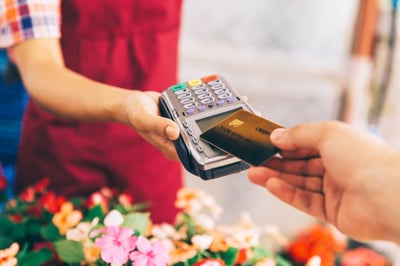
Our digital world has made it easier to do business across borders and around the globe.
But there are still barriers when it comes to making payments and transferring money through traditional modes. Here’s a look at the landscape for global payments, and how digital payments are making it easier to pay and get paid.
How does a marketing company in the United States pay a contract designer in Pakistan? How can a textile manufacturer in Vietnam transfer funds to a silk supplier in India?
As companies participate in the global economy, the question of how to pay and get paid becomes a relevant one. Transfers take longer, are subject to currency exchange, and can be difficult to trace as they navigate through different banking institutions. Businesses need quicker, more reliable means to send and receive money.
Digital payments have risen to prominence as the best solution for sending and reviewing money across borders. Here’s a look at what they are, how they work and how they stack up against traditional modes of global payment.
Digital payments are aptly named. These are online payments a business can execute and process using digital resources. Digital payments can be point-to-point or travel through any number of intermediaries to get to their destination. Regardless of the journey, there’s no physical transfer of cash involved.
A very simple example of a digital payment would be an e-commerce purchase. When you put your credit card details into a website and check out online, payment occurs without any physical transfer of funds.
While simple on the surface, digital payments are incredibly complex in their execution. This is because financial transaction data needs absolute security. Digital payments are only as secure as the platforms that process and handle them – which is to say, extremely secure. Reputable payment processors use various forms of encryption, standardized by organizations such as the PCI Security Standards Council.
Digital payments are the next step forward in global payments. Because they’re processed without cash, in real time, they’re accommodating to any person or business, anywhere in the world.
As world economies become increasingly interconnected, the need for businesses to pay vendors, partners, workers and organizations in other countries will only grow. Unfortunately, there are still obstacles that make it difficult to move money across borders. Digital payments solve many of the physical barriers associated with global payments, including:
The bottom line is that businesses are going digital, and they need a payments solution that matches the technologies they’re already using. In the same way they might share a digital file through the cloud or jump on a video conference with someone across the globe, businesses want the ability to send and receive money with fewer barriers.
The way digital payments work varies from provider to provider. Generally, providers rely on payment networks to leverage payment rails, and users send money from a straightforward, intuitive payment platform.
Payment rails are the different processing modes for cashless payments. Different rails can include cards, bank accounts, the SWIFT network, blockchain, and more.
The process is simple and straightforward. After you sign up with a digital payment provider, you’ll choose the mode of payment you want to use. You’ll also need information for the recipient. Often, this is as simple as entering an email. The digital payment provider handles the rest.
After you send funds, the digital payment provider executes the transfer through the applicable rail. Because everything happens digitally, you have the ability to see the status of the transaction in real time. When the transfer is complete and funds have landed, the recipient can manage their funds however they want – whether that means transfer to a bank account or into a digital wallet.
There are several tailwinds pushing adoption of digital payments. Most pressing is the fact that the SWIFT system, which handles the bulk of cross border payments, was built for a different era. The rise of e-commerce, global supply chains, and the gig economy has made international B2B money transfers more prevalent.
An expanding global marketplace demands more optionality from payment providers. This all added up to major demands for simpler, more efficient, more affordable global payments.
The Society for Worldwide Interbank Financial Telecommunications (SWIFT) is a global network of banking institutions. Its purpose is to send and receive financial transaction data across borders. It’s important to note that SWIFT isn’t responsible for funds transfer – it merely facilitates payment orders.
It’s up to banks within the swift network to settle funds. These transfers aren’t always efficient, and there’s a lack of transparency in how they’re handled. For example, companies sending international payments through the SWIFT network aren’t always privy to the exchange rates on currency.
As global commerce increases, so does demand for more efficiency and transparency in global payments. Businesses need comprehensive tools that allow them to communicate with their partners, and compensate their vendors, contractors and merchants.
This could mean sending money to multiple countries, in various landed currencies, in different intervals. Businesses need more support than the SWIFT network and traditional banks can provide. They’re turning to digital payments to enable more seamless transfer of funds.
Cloud tools, coupled with the rise in remote work positions, have made it possible to tap into a global talent pool of contractors. You can hire a programmer from Israel, a web developer from the Philippines, a graphic artist from Italy and a 3D modeler from Japan – all while working from your office in New York, London, or anywhere else in the world. Gig workers are flexible, accessible, and ready to work, no matter where they are.
As companies increasingly turn to gig workers, they need reliable ways to pay these individuals. Digital payments have quickly risen to the top of the options list because of the benefits they offer. Real-time payments, payment tracking, and the ability to pay unbanked contractors are all major factors that enable digital payments. Plus, the nature of digital wallets makes it easy to overcome currency exchange barriers inherent to a distributed workforce.
Doing business in the global marketplace is more complex than doing business at home. Without access to the resources large corporations have, globalization has traditionally been out of reach for most small businesses and startups.
But with rapid technological advancements in global payments, anyone can access the powerful tools it takes to compete (and win!) in the global marketplace. Smaller businesses are able to be competitive thanks to innovations that save time and money.
Digital payments help small businesses get a leg up on finding international suppliers, contractors, services, customers, and more. By eliminating the middleman for payments, digital payment providers have leveled the playing field as the world transitions to one big economy.
When talking about digital payments, it’s important to note that there are several types to consider. A digital payment is a transaction without cash. As companies think about cross-border business payments, they need to carefully consider which type of global payment is most applicable to their situation. Here’s a look at five types of digital payments and the pros and cons that come with them.
The simplest and most familiar type of digital payment is via a credit or debit card. Almost every business has one, and they’re regularly issued in conjunction with other banking products such as checking accounts.
Businesses can use cards in a variety of different ways, including swiping or inserting at terminals, entering the 16-digit code into a web portal or even reading the card number over the phone. Card transactions are best for small businesses paying for goods and/or services through secure merchant portals, and only through mediums with PCI DSS compliance.
|
Pros |
Cons |
|
|
Local payments actually refer to the banking institutions that process payments. Local payment rails like an automated clearing house (ACH) are great tools for sending large sums of money from one business to another.
This mode of digital payment is highly secure and actually requires very little information outside of routing and account numbers. The downfall is that these institutions offer little visibility into the status or workings of payments. There are costs and time involved in sending and landing a cross-border payment.
|
Pros |
Cons |
|
|
Checks are still a commonly used method of payments for many enterprise-level businesses. And while we tend to think of checks as physical paper payments, digital checks are now common. Digital check payments act just like their physical counterparts, which means recipients can deposit them at a bank or use third-party tools to cash them.
These payments are a short jump from physical paper checks and leave a similar digital paper trail. Digital checks are easy to disburse and account for, making them a preferred method when paying vendors.
|
Pros |
Cons |
|
|
Wallets are “pure” digital payments, meaning they don’t rely on any sort of institutional bank account or line of credit. Digital payment platforms host wallets and facilitate funds transfers between other wallets and traditional bank accounts. Wallet payments occur quickly and it’s easy for businesses and payees to see the transfer of funds in real time.
There’s very little information required to execute digital wallet payments – often just an email address or a wallet ID number. Moreover, wallets can hold funds in any currency, which eliminates one of the biggest barriers in cross-border payments.
|
Pros |
Cons |
|
|
Wire transfers are the common way to send money around the world through traditional banking institutions. Businesses can send a wire transfer through any bank that’s part of the SWIFT network, and many third-party wire services as well. Sending money through a wire incurs a fee (set by the provider) that’s usually rather high. Moreover, because wire transfers occur through the SWIFT network, there’s very little transparency from Point A to Point B.
|
Pros |
Cons |
|
|
Cryptocurrency isn’t what you’d call a “common” digital payment option, but its rapid rise to prominence makes it worth the mention. Blockchain-backed coins such as Bitcoin, Ethereum, and even Dogecoin are gaining steam as viable currency.
Paying global partners in crypto takes some doing – you and your recipient will need digital wallets that accept crypto assets. There are also crypto tax and reporting implications to consider, which aren’t fully clarified by domestic or international revenue agencies. Safe to say that cryptocurrency is on the global payments radar, but not quite a prominent player yet.
|
Pros |
Cons |
|
|
There are more ways than ever to send money around the world. Whether you’re paying a contractor in Spain, ordering from a vendor in China or receiving funds from a partner in Brazil, it’s important to consider how that money moves across borders. Do you send a digital check? Wire the money? Send payment between two digital wallets? The answer depends on the context of the payment.
No matter how they choose to send payment, one thing is certain: more and more businesses are looking for ways to transfer money internationally. The good news is, there’s an abundance of tools out there to help them do it. From SWIFT and ACH transfers, to digital wallets and checks, to credit cards and even cryptocurrency, businesses have options.
In today’s global, digital age, modern businesses need the ability to send and receive money across borders. Digital global payments allow them to do it efficiently, transparently and affordably. The result is a global economy that continues to get bigger and grow stronger.
Marwan Forzley is the co-founder and CEO of Veem, a global payments network. He is also the author of “Small Business in a Big World: A Comprehensive Guide to Doing International Business,” which teaches small businesses everything they need to know about taking their operations to the international level, from business culture to negotiation tactics.
The global economy is undergoing significant shifts with high interest rates, increased...
 by Evie Parker
by Evie Parker
Shoppers hate long checkout lines.
 by Sneh Choudhary
by Sneh Choudhary
If you’ve heard of Bitcoin, Ethereum, or even Dogecoin, you’ve heard about cryptocurrencies.
 by Alyssa Towns
by Alyssa Towns
The global economy is undergoing significant shifts with high interest rates, increased...
 by Evie Parker
by Evie Parker
Shoppers hate long checkout lines.
 by Sneh Choudhary
by Sneh Choudhary


